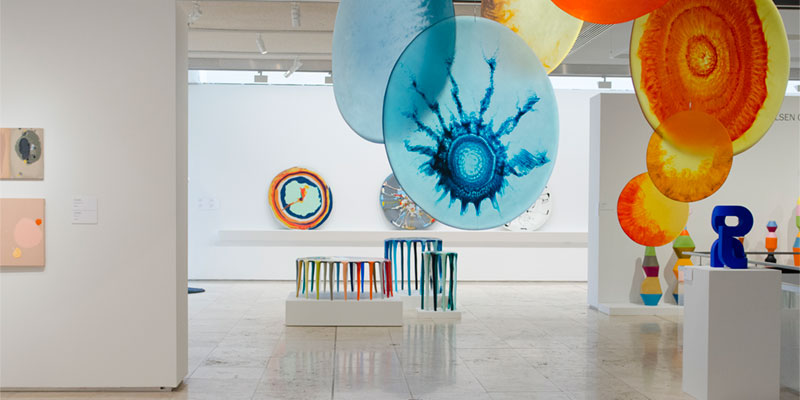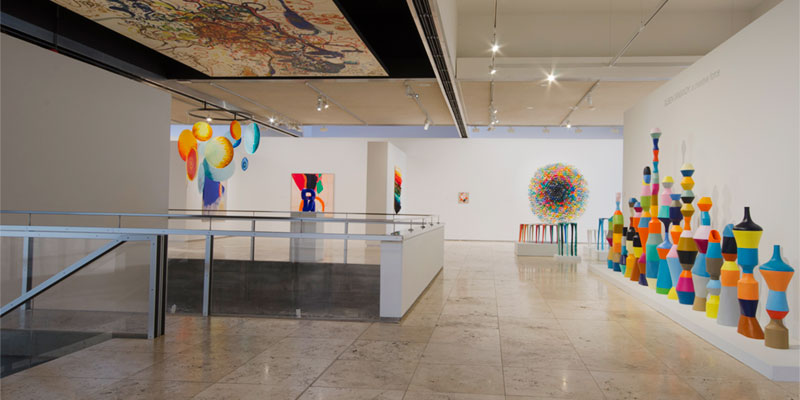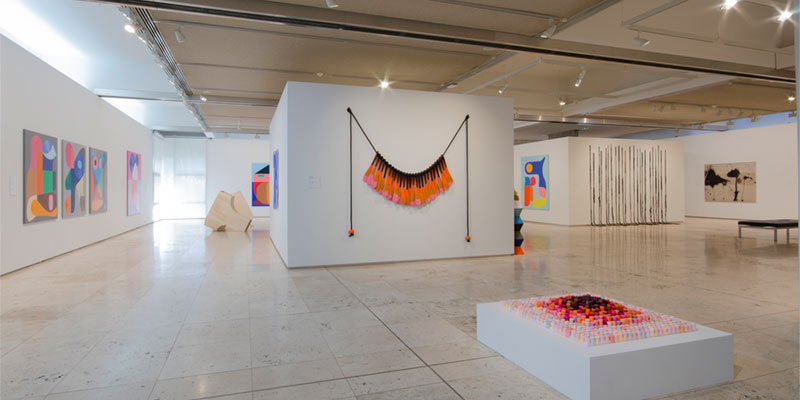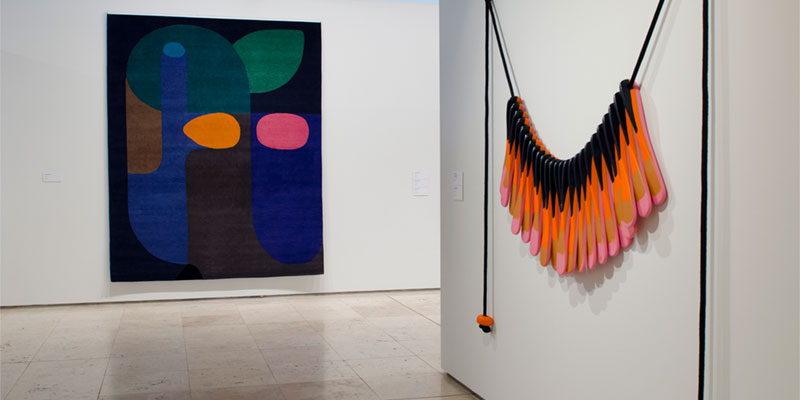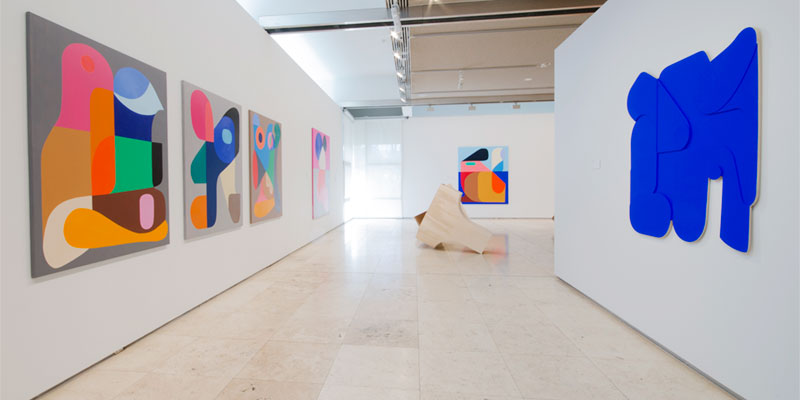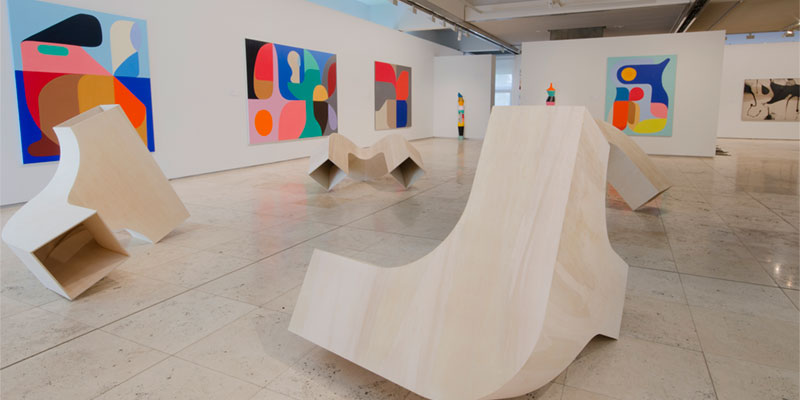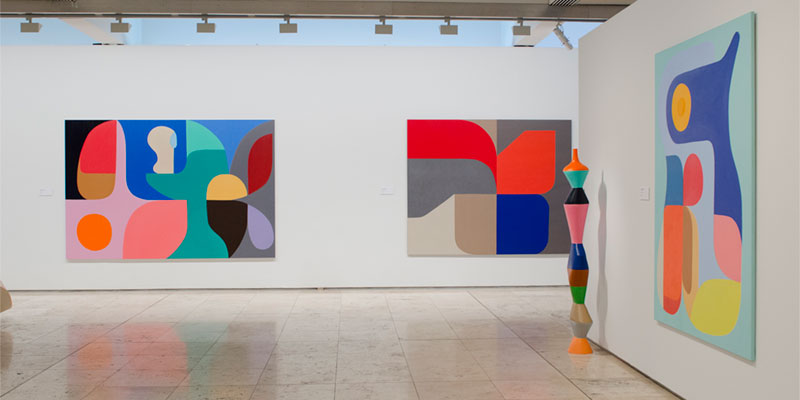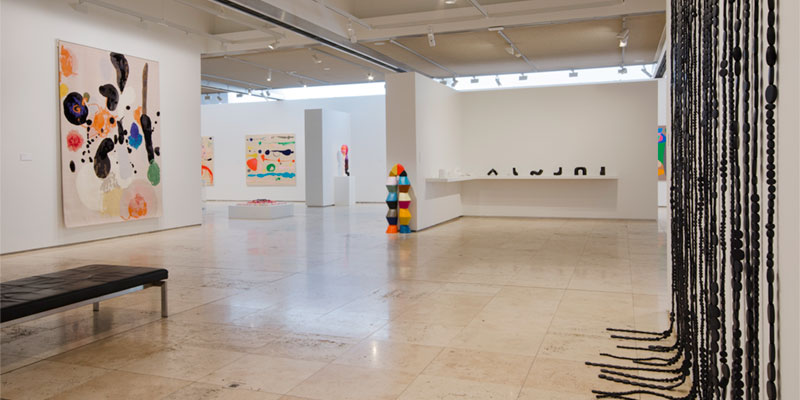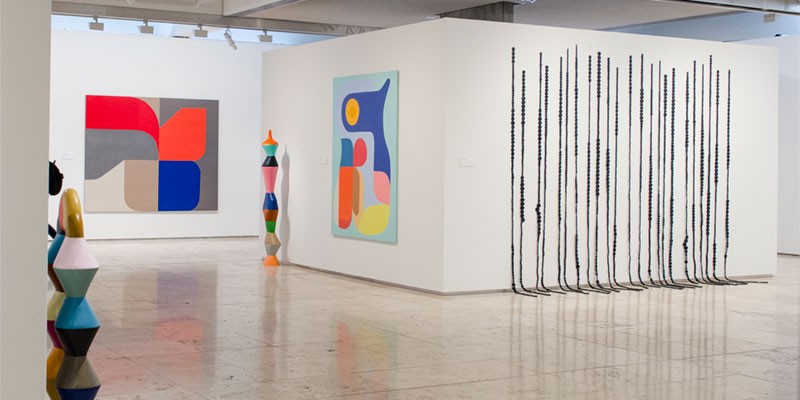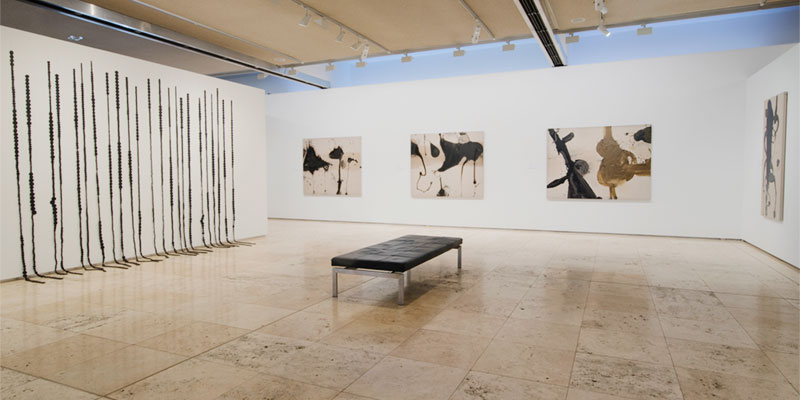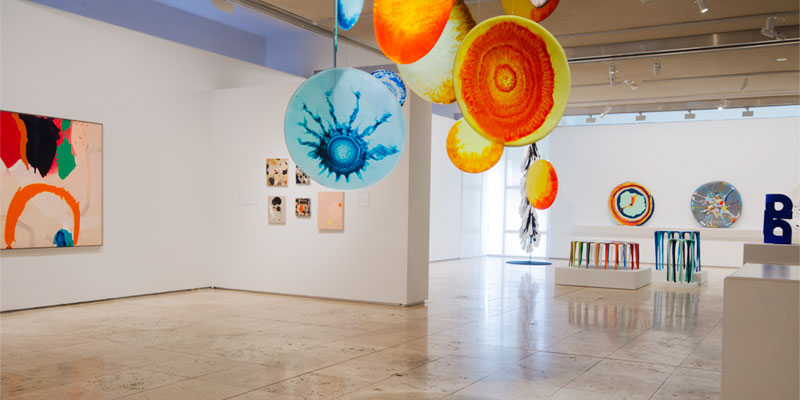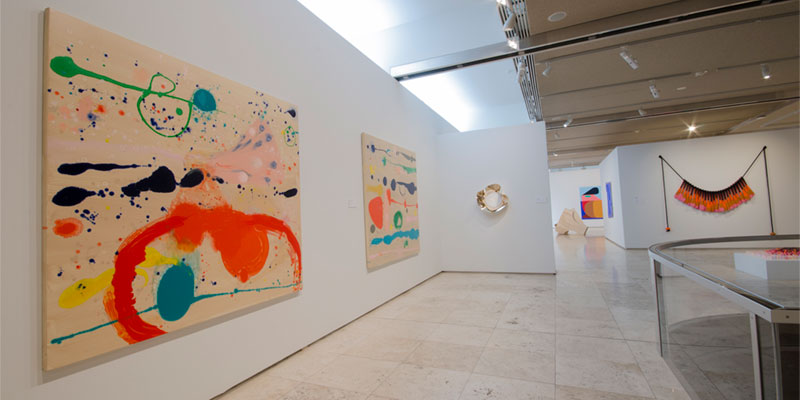Exhibitions
Olsen Ormandy:
Newcastle Art Gallery
17 November 2018 - 17 February 2019
Olsen Ormandy:
a creative force
Newcastle Art Gallery
17 November 2018 - 17 February 2019
Installation images courtesy of Newcastle Art Gallery
Please note: Works may no longer be available as shown and prices may be subject to change to reflect current market value. Please contact the gallery for assistance. Thank you
Our paths first crossed at art school in the early 1980s. As I was beginning my final undergraduate year at what was then City Art Institute [now UNSW Art & Design] Louise Olsen and Stephen Ormandy arrived in first year and seemed to be, even then, fully formed identities. Louise was of course a part of the Olsen family, well known bunyip art royalty, and Stephen, perhaps not so well known, but with the look and apparent confidence of a mid-80s rock star.
Their talent matched their aura, and within a few years Olsen and Ormandy - and Liane Rossler - established what would become Dinosaur Designs, first as a stall at Sydney's Paddington Markets, then quickly expanding into an international presence. Their company is one of the success stories of Australian design, and now, some three decades and change later, Olsen and Ormandy's artistic identity has been primarily linked to their brand.
But of course, that is not the whole story. Both Olsen and Ormandy have continued to work as artists, their complementary practices in painting and sculpture connecting to their design work. Reading their press, it is often noted that they are ‘also artists' as though this is a surprise. The reality of a creative career is that limits or borders between disciplines are largely illusory, and meaningful connections can be drawn between their individual practices, their shared interests and enthusiasms, and the exacting and rigorous standards they apply to all their work.
For every artist there is a will to perfection. Even when their creative processes allow for all sorts of happy accidents, playful collisions or unexpected outcomes, there is also always a need for control, or to at least to set the parameters for the final work. Olsen and Ormandy's art is inextricably bound to their shared aspiration for what they call ‘an effortless sense of completion'. One does not look at their art and imagine that it all just happened by chance.
Olsen's initial inspiration for her art is often literally drawn from nature. Working with sketchbooks to record impressions of the structure and flow of natural shapes and forms, she then finds materials that are analogous to her starting points. Olsen's use of resin, for example, is sensitive to its potentials as its own stuff, as well as it ability to suggest something else, something natural. The ovaloid medallions of resin in her mobile sculptures are first cast into moulds and, while in a porous state, Olsen adds inks to produce hanging pieces that are, in their patterns, lines and shapes, reminiscent of microscopic sea creatures or, at a much grander scale, the sublime scatter of stars of galaxies and nebulae. In a similar process, the table-form sculptures, with their pours of pigment, shell-like surfaces and stalactite legs, recall the jellyfish form that initially inspired the artist. In a duo of sculptural pieces produced for the exhibition, Olsen experimented with the force of gravity and the plastic flow of resin. Placing two sculpted cores on a stand and then pouring viscous, coloured resins over the top, the plastic slowly flowed over the core and off the stand, creating in turn long tendrils. By repeating this process, Olsen has produced works that are akin to the formation of stalactites, but they also suggest ferns or hanging succulents. Although entirely artificial, the results have the appearance of something organic, and alive.
Many of Olsen's wall sculptures, with their undulating spines and protrusions reminiscent of sea caterpillars or spiders, have in fact formed as accretions of wearable pieces amassed together from single smaller scale objects. Inspired by seeing multiples of her jewellery designs laid out on a table, Olsen composed the individual elements into a single work using colour and tonal relationships as her guide, the final form seemingly continuous, but the individual parts of the sculpture all individually hand-made elements.
In her paintings, Olsen will often work with small-scale studies, experimenting with inks, soaking paper, starting with a simple structures and then seeing where the process leads. Olsen's painting is based in a sense of order, but one fascinated with how play can produce unexpected results, albeit within understood limits. Of course, knowing where the limit is - that crucial decision of knowing when to stop - has evolved alongside Olsen's process of working.
There is a core idea for Olsen, a structure to work with, but the journey is all. For an experienced eye - one that has been in training since her childhood among the artistic milieu of Australia's leading modernist artists - a picture can almost ‘speak', telling the artist when to step back, to leave the work in an exquisitely balanced state of completion. If Olsen's process could be said to be about the moment of completion, then Ormandy's work is as much about where a work starts. Ormandy begins his work in both sculpture and painting at the same point - with a general interest in colour, or specifically, such as a work he shows me when I visit his studio, a sculpture made of individually cast plastic pieces that are arranged on a table and looks like a reversed, three dimensional heat map, beginning with lighter shades of his palette of colours at the edges and then growing darker at the centre. It's a piece that began its life as Ormandy contemplated why purple was his least favourite colour. Why was that so? And what could he do with it?
The result is what Ormandy refers to as ‘a banquet for the eye' an array of contrasting and complimentary colours, anchored by a fascination with tonal relationships, an accretion of shape and form into a final object that has its own subtle logic. Ormandy tells me that, over a long period of time, he came to realise that beyond colour relationships, were tonal relationships, which he says are just as important, if not more important, than choosing the colours for his work. The viewer picks up on these tonal relationships subconsciously. This is, in essence, the key to the artist's entire practice. Ormandy's sculptural works have two major threads of production. One is what he refers to as his ‘totems', colourful smaller scale works that sit on the floor, a table top, or plinth. The other sculptural works run in a variety of sizes, and like the totem sculptures they can be domestically scaled, but they are also often major pieces destined for the atria of office buildings, parks or city plazas. Both threads of sculptural works have shared roots in what the artist terms ‘three-dimensional collage' and his interest in polychromatic colour. The totems, with their serial composition of repeating modular shapes, echo the early 20th century modernist sculptor Constantin Brancusi's iconic construction Endless Column, Vers. 1 [1918]. Like that venerated masterwork, Ormandy's totems are produced using repeating forms, a technique he first discovered when he was making vases. By adapting the vase form, and finding they worked as minimalist sculptural pieces that could be joined, inverted, and then repeated, the artist had the ideal base unit for a potentially endless series of variations. By adding new units to the process - pieces specifically designed to be used in the sculptures - Ormandy has even more potential variation, a way to produce, ‘as many different rhythms that can be built out a limited set of variables'. The next stage in the process is to add colour to the faceted surfaces of the individual units - a collage of colours that create a kind of spectral logic in the work, what the artist refers to as the ‘pop and resonance' of the composition. The pieces are freestanding and seem reminiscent of traditional ‘tribal' art, but because of their > construction in resin, they're intimately connected to an industrial mode of production, albeit one that's largely hand produced.
The second thread of works is bound up in the essential geometry of classical minimalism. It's no surprise to discover that, along with the work of artists Pablo Picasso and Robert Klippel, Ormandy also acknowledges the influence of sculptors Clement Meadmore, Eduardo Chillida and Tony Smith, artists whose work explored the potential of a singular sculptural language that, while self contained, also suggested a flow in their use of curves, turns, and loops. There is a certain orthodoxy to the geometric shapes that Ormandy favours that connect him to his influences, but Ormandy's works also continue from the totems what might be termed the sculptural ‘logic of shapes', again a series of individual units that lock and join into further iterations and variations. Ormandy brings colour to these works too, something that his cited influences rarely, if ever, did. The artist's addition of carefully chosen colours to facets and planes of the sculptures adds an extra layer to their dimensionality, a kind of puzzle for the eye as one tries to resolve how they fit together - and why. The notion of interlocking shapes and colours is a connection to Ormandy's paintings. The same sort of visual logic seems to underpin their creation, but where the sculptures have an industrial look to them, the paintings are another proposition. The shock is to discover that Ormandy doesn't paint in acrylics and he doesn't use any kind of masking tape to create the edges. Instead he paints in oils, favouring the paints' luminosity and malleability, and he'll often draw free hand on to the canvas with chalk, experimenting with the relationships between composition and scale. Other times Ormandy works from small-scale collages created from commercial colour swatches, cutting the sharp edges of the samples into softer lozenges of tertiary colours that can then be worked together. Or Ormandy might just as well experiment with photographing older paintings and isolating an interesting intersection of the composition, or he might even experiment with Photoshop to build a palette.
However he might work, the resulting paintings have a similar sense of classical modernism as his sculptures, but with the same ineffable sense of the present too. His hand-painted works have a suppleness that would be missing if they were produced en masse, using hard edge techniques. Ormandy tells me that our eyes are always seeking out perfection, searching out the flawless edge and simple contrast of colours of manufactured objects. But in nature the eye rarely sees those kinds of combinations, instead sensing the soft edge, the imperfect line, the blend of colour and shade. When we have the same kind of sensation in art - the kind of impression we have in Ormandy's paintings - they too feel ‘natural', and perhaps more importantly, achieve the ‘effortless sense of completion' that both Ormandy and Olsen strive for.
There is an obvious and continuous aesthetic at play, linking the work of these artists; a deliberate engagement with beauty in surface, form and colour. Their sculptural pieces have an almost irresistible sense of tactility to them, an attraction that compels the viewer to want to trace a finger along an edge or surface. The notion of the ‘natural' is another strong connective link in their work, a drive for a convincing simplicity, one that arises from a shared vision of the creative process as something innate, but also exercised, expanded and strengthened over a long period of time. The key to building a visual language, Ormandy tells me, is to make the grammar of creativity as versatile as possible. One senses that versatility, but also a creative strength. Where does it come from? Talking over coffees in her office, Olsen reflects on the shared disciplines of being artists and designers. ‘You have to switch your brain around a little bit,' she says. ‘But there are the same kind of < rigours, in critically analysing your thinking and making.' Looking at the duo's work over the decades there is an irrefutable logic at work, one that is as seductive as it is beautiful.
- Dr Andrew Frost
